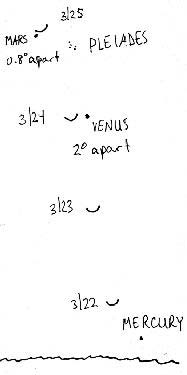This week, the planets are the main event, and sunset is the time to see them. All five naked-eye planets are visible in the early evening. Even early-to-bed types can tour the solar system without losing sleep.
The four brightest planets - Venus, Mars, Jupiter, and Saturn, have been visible for some time now. For a couple of weeks, Mercury will also be visible in the dusk glow.

Mercury is the planet closest to the sun. In some ways it resembles our own moon - similar in size, and a target for celestial debris because it lacks an atmosphere. This has another surprising effect. Mercury is less than half the distance of the earth to the sun. Predictably, this makes for some mighty hot days, up to 740 degrees Fahrenheit. Without the stabilizing influence of an atmosphere, though, nights are shockingly cold, with temperatures plunging past -300 degrees.
Some of those days and nights are long, too. Mercury orbits the Sun in 88 days, and rotates on its axis every 59 days. The result is that the sun can be illuminate the same point on Mercury's surface for up to three months at a time, tracing a ragged path back and forth across the sky.
Because it is so close to the sun, Mercury is always less than 30 degrees away from the sun as we observe it. Much of that time it is lost in the sun's glare. When Mercury is visible, it is only for a few weeks at a time. It stays close to the horizon in early evening or early morning twilight. An unobstructed horizon is vital for viewing the planet.
Mercury is rising higher in the sky now, and will reach its highest point on March 29. Then, it will descend back into the sun's glow over the next two weeks. On March 21 and 22, the one- and two-day old moon will be nearby in the very early in the evening. On the 22nd, look for Mercury to the right and below the moon.
During the week, the waxing crescent moon will also visit bright Venus on the 24th. Venus is also nearing its highest point in the sky for this season. March 25, the moon will visit Mars. Mars and Venus are on either side of the Pleiades, making an excellent target for astrophotographers. Saturn, high overhead at sunset, and Jupiter, prominent in the west and visible most of the night, round out the planetary show.

The Piker Press moderates all comments.
Click here for the commenting policy.